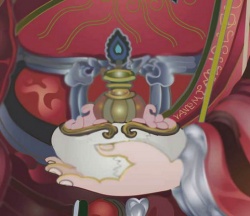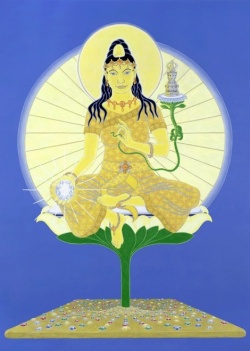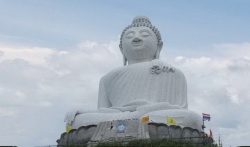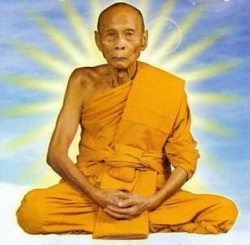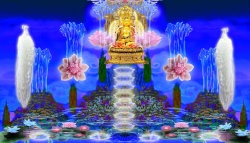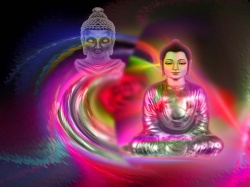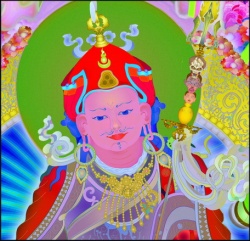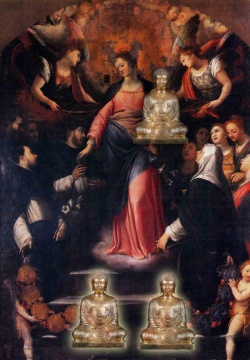Dharma classification to 5 aggregates: skandha
Beneficial, Unbeneficial and Neutral Dharmas
The distinction of dharmas into “Beneficial”, “Unbeneficial” and “Neutral” (kušala, akušala and avyakrta) observes dharmas from the point of view of theory of salvation.
Some dharmas, for example, what I described in my previous post, “Without Anxiety” (anasrava) are “Beneficial”, i.e.
they are helping to reach the salvation. Others, in turn, are “Unbeneficial”, which slow down the process of liberation: those are elements of Anxiety that retain a personality in the cyclic existence.
Finally, the third group doesn’t determine the process of gradual movement towards enlightenment in any way but are neutral.
It would not be correct to talk here about distinction to “good” or “bad” elements, because we are not talking about the meaning of elements in the moral sense.
Of course, the final religious goal in Buddhism, like in many other religions, is closely related to the ethical questions. However to determine the value of elements of being, Buddhism is guided by the ideal of liberation.
3 types of psychological dharma classifications
Answering the question why Buddha speaking on the objects of enquiry observed them in 3 ways, i.e. divided them in Aggregates (Skandha),
Bases (of Consciousness) and classes (dhātu) of elements, Vasubandhu in AK1; 20 says:
“Living beings use to have delusions of 3 kinds:
Some are in illusions in regards to psychic phenomena, viewing it as an atman, “I”, others – in regards to matter, and the third group – in regards to matter and consciousness together.”
Also there are beings with 3 kinds of abilities:
large, medium and small. Dispositions are alike: some beings can comprehend faster short teachings, some need medium, and some need long teachings.
Three methods of dharma explanations are intended for these 3 kinds of students”.
In that way, each of the 3 dharma classifications has a different turn from the viewpoint of psychological analysis. But each of them contains all the same 75 (or according to some tradition 100) types of dharmas.
5 Aggregates (Skandha)
According to classification of dharmas to 5 groups or aggregates, traditionally they are listed in the following order:
Forms (or “matter”)(rūpa) - all external and internal matter is included here; according to philosophical definition the matter is what has a form and colour
Feelings (or “senses”)(vedanā)
Notions or conceptions (samjnā)
Factors of Formation (samskāra) - "impulses",
"volition", or "compositional factors"; encompasses all types of mental habits, thoughts, ideas, opinions, prejudices, compulsions, and decisions triggered by an object.
Consciousness (Vijñana) – without any content.
Skandha can be literary translated as "heap". Vasubandhu explains the notion “group” (skandha) referring to a Buddhist Sutra:
“All matter – past, present and future, inner and external, rough and smooth, low and high, near and far – all of that together is called a group of matter” (AK1; 20). Similarly, also all other groups are formed.
Additionally Vasubandhu points out other characteristics of dharmas gathered in the groups.
The “Low” dharmas are those contaminated with inflow of affections, the “High” dharmas are without an inflow of affections.
The “Far” are dharmas of past and future, the “Near” – dharmas of the present.
Likewise are separated the gross and subtle dharmas, the ones perceived by 5 senses and others perceived by mind.
For this reason in two separate groups are physical sensations and notions divided.
For instance, feelings of liking, aversion and neutral are analysed separately from phenomena in relation to which they are experienced.
Also, we have to remember that in none groups are not include so-called “unsubordinated to existence” or unconditioned dharmas, since they don’t correspond to the meaning of the notion of a group, which asserts a group is a heap or gathering of dharmas of the past, present and future.
For this reason the unconditioned dharmas (asamskrta dharmas) cannot be combined in a group (skandha):
They don’t manifest themselves and don’t disappear, giving no matter to gather in a group.
The ordering of groups is determined according to the grossness and psychic activity of dharmas: beginning with a matter, which has impermeability and is considered the most “gross”, to the group of Consciousness that includes the most subtle dharmas.
From the viewpoint of Buddhist psychology important to note that in groups (skandha) is dived not just a separate moment in the flow of consciousness, but all complicity of dharmas included in a structure of particular personality.
Including the ones which have been manifested in the past and which can manifest them at some point in the future.
The definitions to 5 skandha in Abhidharmakoša by Vasubandhu are:
1.Rupa Skandha : 5 sense organs, 5 sense objects and avijnapti:
The 5 sense organs are the subtle materiality of the eye, ear, nose, tongue and body. (K9)
The 5 sense objects are defined as follows: (K10)
Visible matter is color and form, or twenty-fold: four primary colors (blue, red, yellow, white), eight more colors (cloud, smoke, dust, mist, shade, glare, glow, darkness), and eight forms (long, short, square, round, high, low, even, uneven).
The Sautrantika only admit colour, not shape or form, as a dharma.
Sound is eightfold:
caused by
(1) animate or (2) inanimate beings, (3) articulate speech and (4) non-articulate sound,
and in all 4 cases, either agreeable or disagreeable.
Taste is sixfold: sweet, sour, salty, pungent, bitter, astringent.
Smell is fourfold: good and bad odours that are either excessive or non-excessive.
Tangibles are elevenfold:
four primary elements (earth/solidity, water/humidity, fire/heat, wind/motion), softness, hardness, weight, lightness, cold, hunger, thirst.
]]Avijnapti\\: “That serial continuity - pure or impure - which exists even in one whose thought is distracted or who is without thought, and which is dependent on the Great Elements, is called the non-informative (avijnapti) (matter).” (K11)
2.Vedana Skandha:
“The aggregate of feeling (vedana-skandha) comprises three types of affects: pleasure (sukha), suffering (duhkha), and neither-suffering-nor-pleasure (aduhkhasukha). Again, that (aggregate) can be divided into six groups of feeling (vedana-kaya): from feeling born of eye-contact through feeling born of mind-contact.” (K14)
3.Samjna Skandha:
“This is the aggregate of ideas, namely the apprehension (grahana) of „marks‟ (nimitta) such as blue or yellow, long or short, female or male, friend or enemy, and so on.” (K14) (grahana: “grasping”, “determining”)
4.Samskara Skandha:
“Saṁskāraskandha are the saṁskāras different from the other four skandhas” (K15)
5.Vijñana Skandha:
“Consciousness is the impression relative to each object.”
The division of dharmas into 5 aggregates (skandha) is used in Buddhist philosophical literature, but not too often, because it is not detailed enough to describe properly more complicated psychological analyses. Often are used dharma classifications to 18 classes of elements (dhātu) or 12 bases of consciousness (āyatana). </poem>
